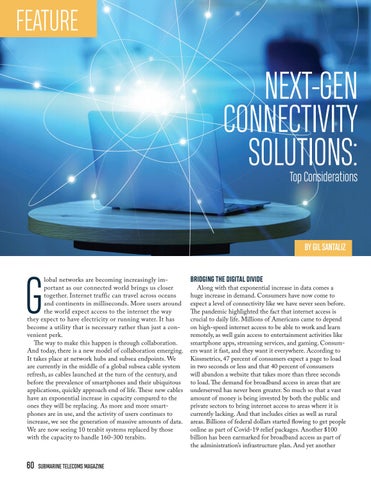FEATURE
NEXT-GEN CONNECTIVITY SOLUTIONS: Top Considerations
BY GIL SANTALIZ
G
lobal networks are becoming increasingly important as our connected world brings us closer together. Internet traffic can travel across oceans and continents in milliseconds. More users around the world expect access to the internet the way they expect to have electricity or running water. It has become a utility that is necessary rather than just a convenient perk. The way to make this happen is through collaboration. And today, there is a new model of collaboration emerging. It takes place at network hubs and subsea endpoints. We are currently in the middle of a global subsea cable system refresh, as cables launched at the turn of the century, and before the prevalence of smartphones and their ubiquitous applications, quickly approach end of life. These new cables have an exponential increase in capacity compared to the ones they will be replacing. As more and more smartphones are in use, and the activity of users continues to increase, we see the generation of massive amounts of data. We are now seeing 10 terabit systems replaced by those with the capacity to handle 160-300 terabits.
60
SUBMARINE TELECOMS MAGAZINE
BRIDGING THE DIGITAL DIVIDE
Along with that exponential increase in data comes a huge increase in demand. Consumers have now come to expect a level of connectivity like we have never seen before. The pandemic highlighted the fact that internet access is crucial to daily life. Millions of Americans came to depend on high-speed internet access to be able to work and learn remotely, as well gain access to entertainment activities like smartphone apps, streaming services, and gaming. Consumers want it fast, and they want it everywhere. According to Kissmetrics, 47 percent of consumers expect a page to load in two seconds or less and that 40 percent of consumers will abandon a website that takes more than three seconds to load. The demand for broadband access in areas that are underserved has never been greater. So much so that a vast amount of money is being invested by both the public and private sectors to bring internet access to areas where it is currently lacking. And that includes cities as well as rural areas. Billions of federal dollars started flowing to get people online as part of Covid-19 relief packages. Another $100 billion has been earmarked for broadband access as part of the administration’s infrastructure plan. And yet another
